Business Environment and Business Organisation Analysis: Sainsbury's
VerifiedAdded on 2020/11/12
|17
|4299
|111
Report
AI Summary
This report provides a comprehensive analysis of the business environment, focusing on Sainsbury's, a prominent supermarket chain in the UK. The report begins with an introduction to business and its environment, then classifies different types of business organizations, including public, private, and voluntary sectors, highlighting their objectives, scope, and impact on the economy. The report then delves into the specifics of Sainsbury's, examining its size, scope, mission, and vision. It explores the interrelatedness of various business departments, such as Human Resources, Finance, Marketing, and Production, and their roles in achieving organizational objectives. Furthermore, the report includes both SWOT and PESTLE analyses to assess the internal strengths, weaknesses, opportunities, and threats, as well as the external political, economic, social, technological, legal, and environmental factors affecting Sainsbury's. The report is a detailed overview of Sainsbury's operations and its environment.
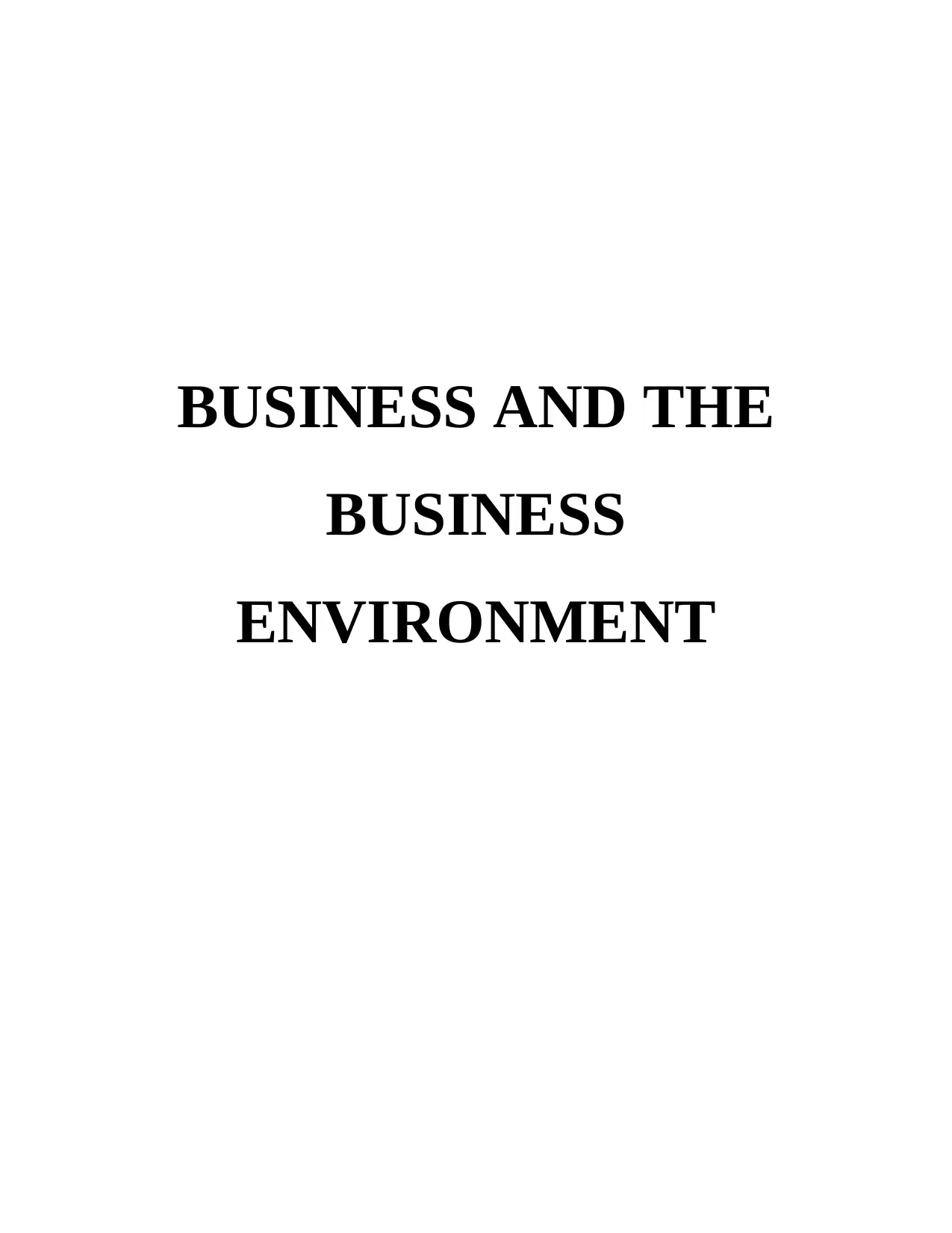
BUSINESS AND THE
BUSINESS
ENVIRONMENT
BUSINESS
ENVIRONMENT
Paraphrase This Document
Need a fresh take? Get an instant paraphrase of this document with our AI Paraphraser

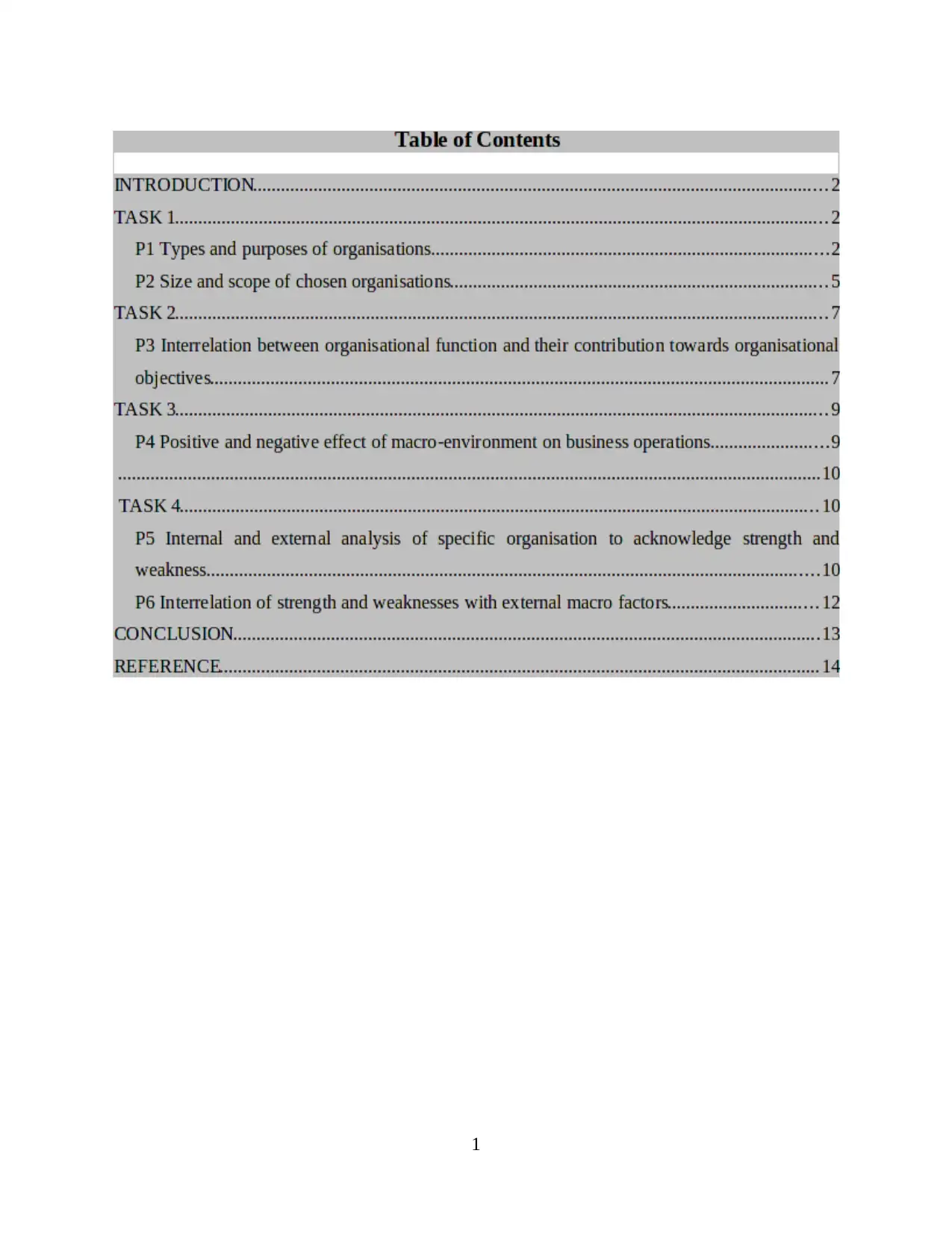
1
⊘ This is a preview!⊘
Do you want full access?
Subscribe today to unlock all pages.

Trusted by 1+ million students worldwide
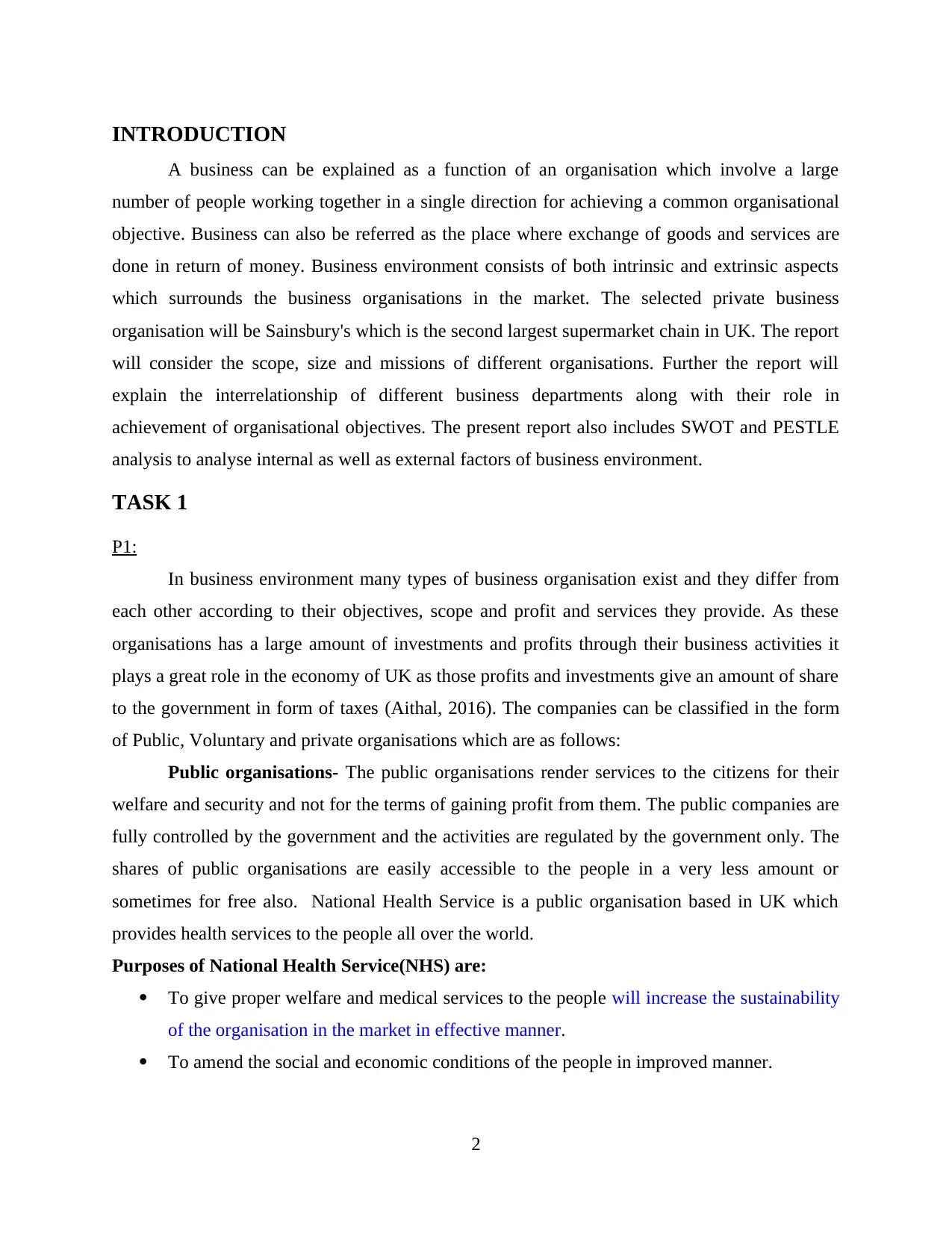
INTRODUCTION
A business can be explained as a function of an organisation which involve a large
number of people working together in a single direction for achieving a common organisational
objective. Business can also be referred as the place where exchange of goods and services are
done in return of money. Business environment consists of both intrinsic and extrinsic aspects
which surrounds the business organisations in the market. The selected private business
organisation will be Sainsbury's which is the second largest supermarket chain in UK. The report
will consider the scope, size and missions of different organisations. Further the report will
explain the interrelationship of different business departments along with their role in
achievement of organisational objectives. The present report also includes SWOT and PESTLE
analysis to analyse internal as well as external factors of business environment.
TASK 1
P1:
In business environment many types of business organisation exist and they differ from
each other according to their objectives, scope and profit and services they provide. As these
organisations has a large amount of investments and profits through their business activities it
plays a great role in the economy of UK as those profits and investments give an amount of share
to the government in form of taxes (Aithal, 2016). The companies can be classified in the form
of Public, Voluntary and private organisations which are as follows:
Public organisations- The public organisations render services to the citizens for their
welfare and security and not for the terms of gaining profit from them. The public companies are
fully controlled by the government and the activities are regulated by the government only. The
shares of public organisations are easily accessible to the people in a very less amount or
sometimes for free also. National Health Service is a public organisation based in UK which
provides health services to the people all over the world.
Purposes of National Health Service(NHS) are:
To give proper welfare and medical services to the people will increase the sustainability
of the organisation in the market in effective manner.
To amend the social and economic conditions of the people in improved manner.
2
A business can be explained as a function of an organisation which involve a large
number of people working together in a single direction for achieving a common organisational
objective. Business can also be referred as the place where exchange of goods and services are
done in return of money. Business environment consists of both intrinsic and extrinsic aspects
which surrounds the business organisations in the market. The selected private business
organisation will be Sainsbury's which is the second largest supermarket chain in UK. The report
will consider the scope, size and missions of different organisations. Further the report will
explain the interrelationship of different business departments along with their role in
achievement of organisational objectives. The present report also includes SWOT and PESTLE
analysis to analyse internal as well as external factors of business environment.
TASK 1
P1:
In business environment many types of business organisation exist and they differ from
each other according to their objectives, scope and profit and services they provide. As these
organisations has a large amount of investments and profits through their business activities it
plays a great role in the economy of UK as those profits and investments give an amount of share
to the government in form of taxes (Aithal, 2016). The companies can be classified in the form
of Public, Voluntary and private organisations which are as follows:
Public organisations- The public organisations render services to the citizens for their
welfare and security and not for the terms of gaining profit from them. The public companies are
fully controlled by the government and the activities are regulated by the government only. The
shares of public organisations are easily accessible to the people in a very less amount or
sometimes for free also. National Health Service is a public organisation based in UK which
provides health services to the people all over the world.
Purposes of National Health Service(NHS) are:
To give proper welfare and medical services to the people will increase the sustainability
of the organisation in the market in effective manner.
To amend the social and economic conditions of the people in improved manner.
2
Paraphrase This Document
Need a fresh take? Get an instant paraphrase of this document with our AI Paraphraser
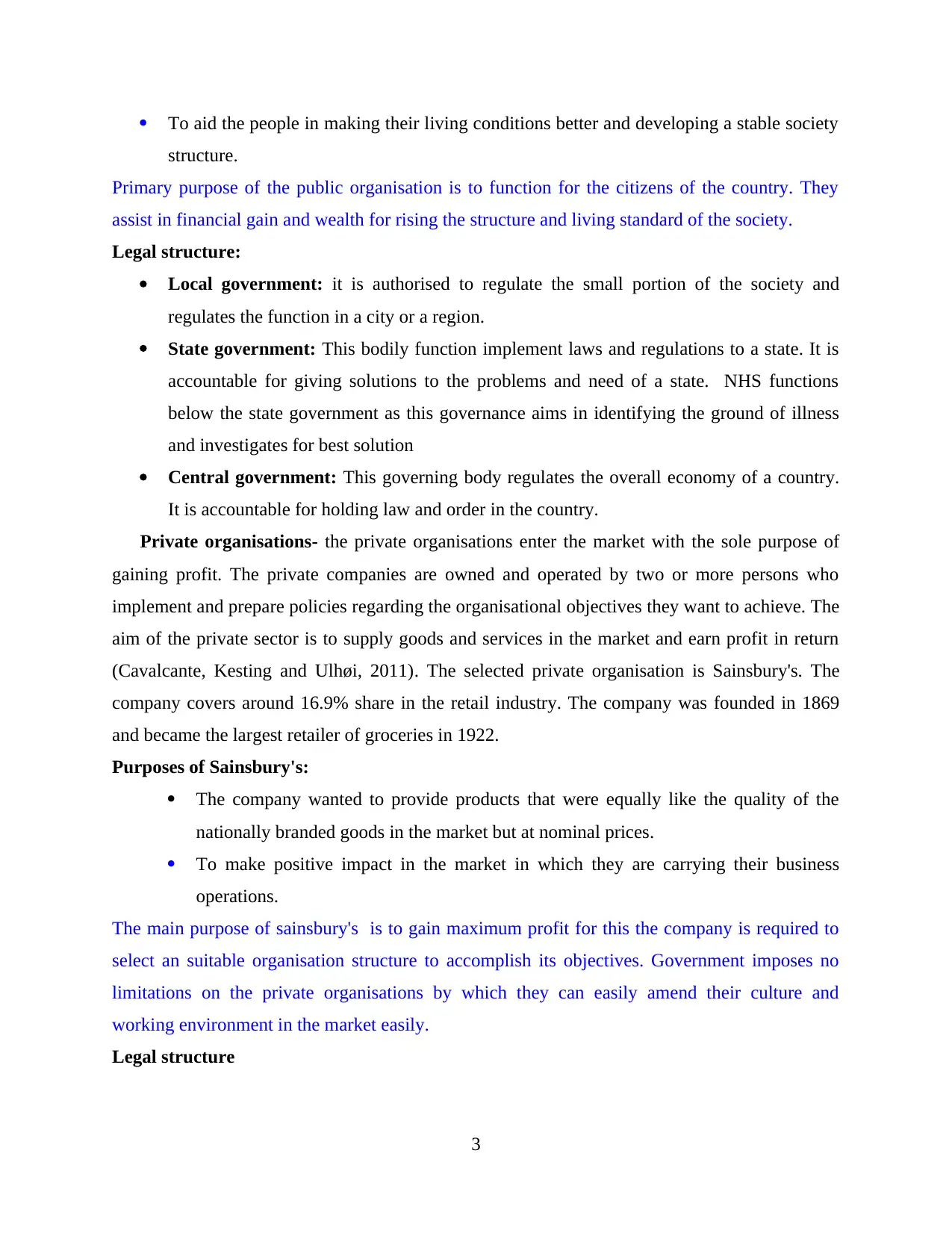
To aid the people in making their living conditions better and developing a stable society
structure.
Primary purpose of the public organisation is to function for the citizens of the country. They
assist in financial gain and wealth for rising the structure and living standard of the society.
Legal structure:
Local government: it is authorised to regulate the small portion of the society and
regulates the function in a city or a region.
State government: This bodily function implement laws and regulations to a state. It is
accountable for giving solutions to the problems and need of a state. NHS functions
below the state government as this governance aims in identifying the ground of illness
and investigates for best solution
Central government: This governing body regulates the overall economy of a country.
It is accountable for holding law and order in the country.
Private organisations- the private organisations enter the market with the sole purpose of
gaining profit. The private companies are owned and operated by two or more persons who
implement and prepare policies regarding the organisational objectives they want to achieve. The
aim of the private sector is to supply goods and services in the market and earn profit in return
(Cavalcante, Kesting and Ulhøi, 2011). The selected private organisation is Sainsbury's. The
company covers around 16.9% share in the retail industry. The company was founded in 1869
and became the largest retailer of groceries in 1922.
Purposes of Sainsbury's:
The company wanted to provide products that were equally like the quality of the
nationally branded goods in the market but at nominal prices.
To make positive impact in the market in which they are carrying their business
operations.
The main purpose of sainsbury's is to gain maximum profit for this the company is required to
select an suitable organisation structure to accomplish its objectives. Government imposes no
limitations on the private organisations by which they can easily amend their culture and
working environment in the market easily.
Legal structure
3
structure.
Primary purpose of the public organisation is to function for the citizens of the country. They
assist in financial gain and wealth for rising the structure and living standard of the society.
Legal structure:
Local government: it is authorised to regulate the small portion of the society and
regulates the function in a city or a region.
State government: This bodily function implement laws and regulations to a state. It is
accountable for giving solutions to the problems and need of a state. NHS functions
below the state government as this governance aims in identifying the ground of illness
and investigates for best solution
Central government: This governing body regulates the overall economy of a country.
It is accountable for holding law and order in the country.
Private organisations- the private organisations enter the market with the sole purpose of
gaining profit. The private companies are owned and operated by two or more persons who
implement and prepare policies regarding the organisational objectives they want to achieve. The
aim of the private sector is to supply goods and services in the market and earn profit in return
(Cavalcante, Kesting and Ulhøi, 2011). The selected private organisation is Sainsbury's. The
company covers around 16.9% share in the retail industry. The company was founded in 1869
and became the largest retailer of groceries in 1922.
Purposes of Sainsbury's:
The company wanted to provide products that were equally like the quality of the
nationally branded goods in the market but at nominal prices.
To make positive impact in the market in which they are carrying their business
operations.
The main purpose of sainsbury's is to gain maximum profit for this the company is required to
select an suitable organisation structure to accomplish its objectives. Government imposes no
limitations on the private organisations by which they can easily amend their culture and
working environment in the market easily.
Legal structure
3
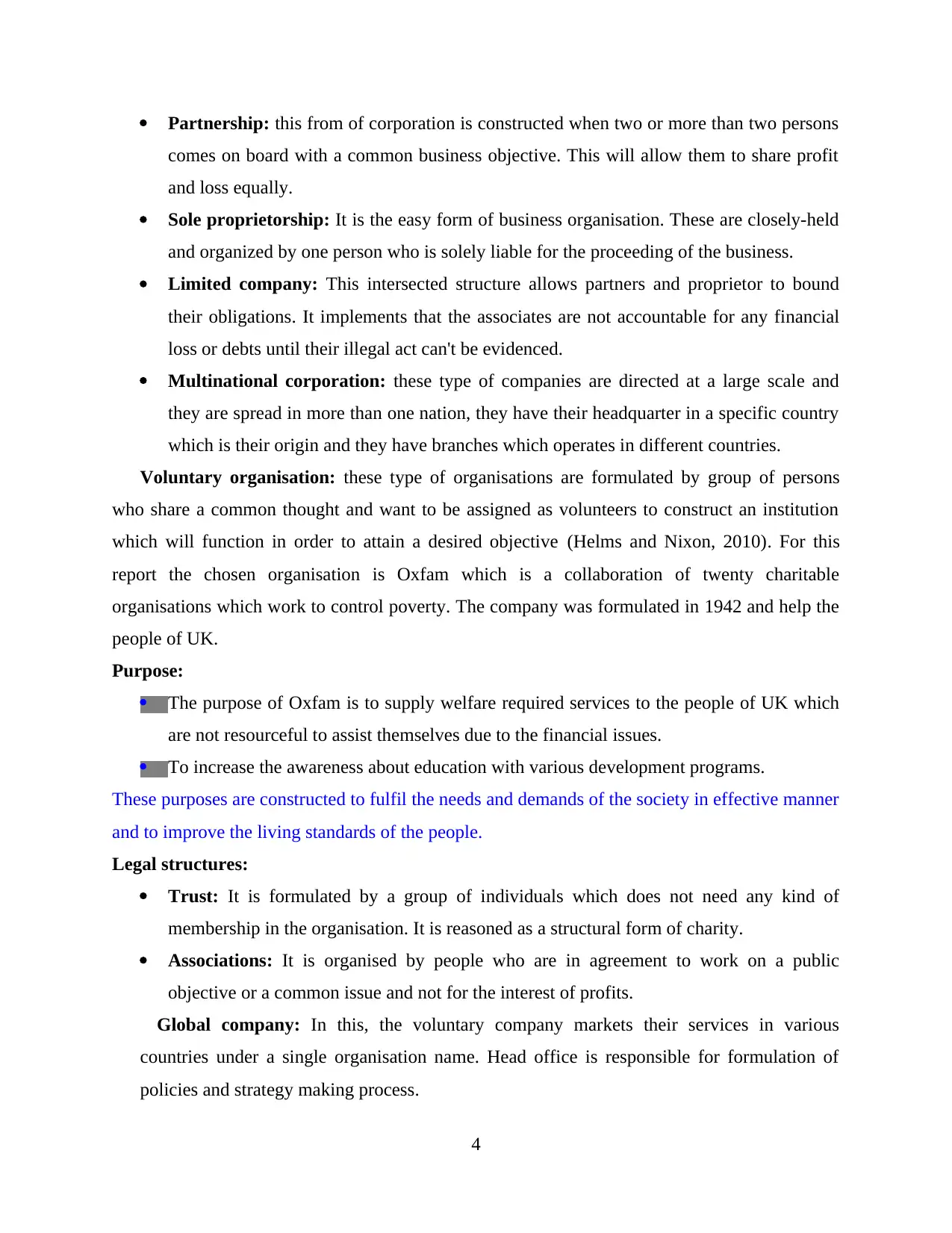
Partnership: this from of corporation is constructed when two or more than two persons
comes on board with a common business objective. This will allow them to share profit
and loss equally.
Sole proprietorship: It is the easy form of business organisation. These are closely-held
and organized by one person who is solely liable for the proceeding of the business.
Limited company: This intersected structure allows partners and proprietor to bound
their obligations. It implements that the associates are not accountable for any financial
loss or debts until their illegal act can't be evidenced.
Multinational corporation: these type of companies are directed at a large scale and
they are spread in more than one nation, they have their headquarter in a specific country
which is their origin and they have branches which operates in different countries.
Voluntary organisation: these type of organisations are formulated by group of persons
who share a common thought and want to be assigned as volunteers to construct an institution
which will function in order to attain a desired objective (Helms and Nixon, 2010). For this
report the chosen organisation is Oxfam which is a collaboration of twenty charitable
organisations which work to control poverty. The company was formulated in 1942 and help the
people of UK.
Purpose:
The purpose of Oxfam is to supply welfare required services to the people of UK which
are not resourceful to assist themselves due to the financial issues.
To increase the awareness about education with various development programs.
These purposes are constructed to fulfil the needs and demands of the society in effective manner
and to improve the living standards of the people.
Legal structures:
Trust: It is formulated by a group of individuals which does not need any kind of
membership in the organisation. It is reasoned as a structural form of charity.
Associations: It is organised by people who are in agreement to work on a public
objective or a common issue and not for the interest of profits.
Global company: In this, the voluntary company markets their services in various
countries under a single organisation name. Head office is responsible for formulation of
policies and strategy making process.
4
comes on board with a common business objective. This will allow them to share profit
and loss equally.
Sole proprietorship: It is the easy form of business organisation. These are closely-held
and organized by one person who is solely liable for the proceeding of the business.
Limited company: This intersected structure allows partners and proprietor to bound
their obligations. It implements that the associates are not accountable for any financial
loss or debts until their illegal act can't be evidenced.
Multinational corporation: these type of companies are directed at a large scale and
they are spread in more than one nation, they have their headquarter in a specific country
which is their origin and they have branches which operates in different countries.
Voluntary organisation: these type of organisations are formulated by group of persons
who share a common thought and want to be assigned as volunteers to construct an institution
which will function in order to attain a desired objective (Helms and Nixon, 2010). For this
report the chosen organisation is Oxfam which is a collaboration of twenty charitable
organisations which work to control poverty. The company was formulated in 1942 and help the
people of UK.
Purpose:
The purpose of Oxfam is to supply welfare required services to the people of UK which
are not resourceful to assist themselves due to the financial issues.
To increase the awareness about education with various development programs.
These purposes are constructed to fulfil the needs and demands of the society in effective manner
and to improve the living standards of the people.
Legal structures:
Trust: It is formulated by a group of individuals which does not need any kind of
membership in the organisation. It is reasoned as a structural form of charity.
Associations: It is organised by people who are in agreement to work on a public
objective or a common issue and not for the interest of profits.
Global company: In this, the voluntary company markets their services in various
countries under a single organisation name. Head office is responsible for formulation of
policies and strategy making process.
4
⊘ This is a preview!⊘
Do you want full access?
Subscribe today to unlock all pages.

Trusted by 1+ million students worldwide
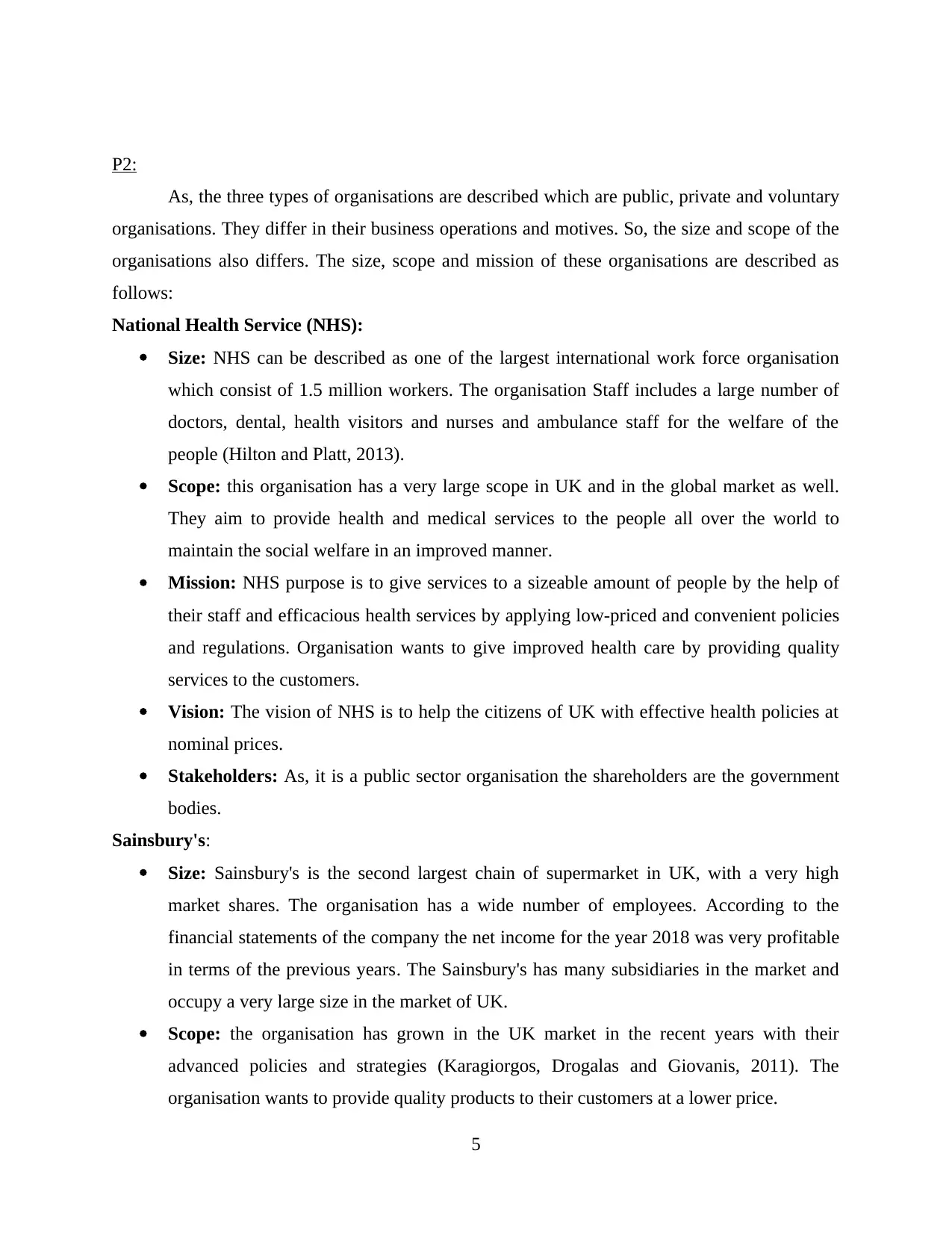
P2:
As, the three types of organisations are described which are public, private and voluntary
organisations. They differ in their business operations and motives. So, the size and scope of the
organisations also differs. The size, scope and mission of these organisations are described as
follows:
National Health Service (NHS):
Size: NHS can be described as one of the largest international work force organisation
which consist of 1.5 million workers. The organisation Staff includes a large number of
doctors, dental, health visitors and nurses and ambulance staff for the welfare of the
people (Hilton and Platt, 2013).
Scope: this organisation has a very large scope in UK and in the global market as well.
They aim to provide health and medical services to the people all over the world to
maintain the social welfare in an improved manner.
Mission: NHS purpose is to give services to a sizeable amount of people by the help of
their staff and efficacious health services by applying low-priced and convenient policies
and regulations. Organisation wants to give improved health care by providing quality
services to the customers.
Vision: The vision of NHS is to help the citizens of UK with effective health policies at
nominal prices.
Stakeholders: As, it is a public sector organisation the shareholders are the government
bodies.
Sainsbury's:
Size: Sainsbury's is the second largest chain of supermarket in UK, with a very high
market shares. The organisation has a wide number of employees. According to the
financial statements of the company the net income for the year 2018 was very profitable
in terms of the previous years. The Sainsbury's has many subsidiaries in the market and
occupy a very large size in the market of UK.
Scope: the organisation has grown in the UK market in the recent years with their
advanced policies and strategies (Karagiorgos, Drogalas and Giovanis, 2011). The
organisation wants to provide quality products to their customers at a lower price.
5
As, the three types of organisations are described which are public, private and voluntary
organisations. They differ in their business operations and motives. So, the size and scope of the
organisations also differs. The size, scope and mission of these organisations are described as
follows:
National Health Service (NHS):
Size: NHS can be described as one of the largest international work force organisation
which consist of 1.5 million workers. The organisation Staff includes a large number of
doctors, dental, health visitors and nurses and ambulance staff for the welfare of the
people (Hilton and Platt, 2013).
Scope: this organisation has a very large scope in UK and in the global market as well.
They aim to provide health and medical services to the people all over the world to
maintain the social welfare in an improved manner.
Mission: NHS purpose is to give services to a sizeable amount of people by the help of
their staff and efficacious health services by applying low-priced and convenient policies
and regulations. Organisation wants to give improved health care by providing quality
services to the customers.
Vision: The vision of NHS is to help the citizens of UK with effective health policies at
nominal prices.
Stakeholders: As, it is a public sector organisation the shareholders are the government
bodies.
Sainsbury's:
Size: Sainsbury's is the second largest chain of supermarket in UK, with a very high
market shares. The organisation has a wide number of employees. According to the
financial statements of the company the net income for the year 2018 was very profitable
in terms of the previous years. The Sainsbury's has many subsidiaries in the market and
occupy a very large size in the market of UK.
Scope: the organisation has grown in the UK market in the recent years with their
advanced policies and strategies (Karagiorgos, Drogalas and Giovanis, 2011). The
organisation wants to provide quality products to their customers at a lower price.
5
Paraphrase This Document
Need a fresh take? Get an instant paraphrase of this document with our AI Paraphraser
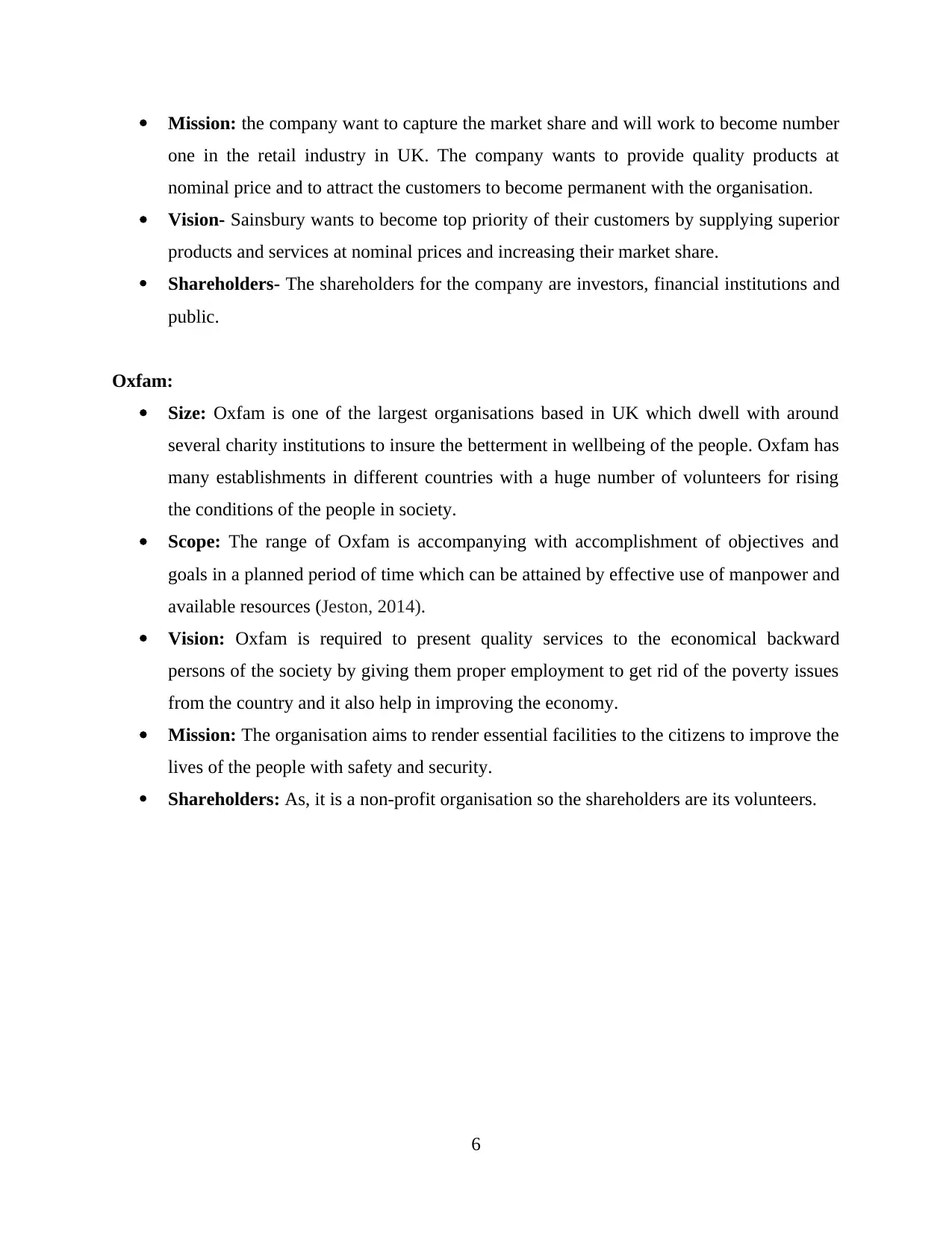
Mission: the company want to capture the market share and will work to become number
one in the retail industry in UK. The company wants to provide quality products at
nominal price and to attract the customers to become permanent with the organisation.
Vision- Sainsbury wants to become top priority of their customers by supplying superior
products and services at nominal prices and increasing their market share.
Shareholders- The shareholders for the company are investors, financial institutions and
public.
Oxfam:
Size: Oxfam is one of the largest organisations based in UK which dwell with around
several charity institutions to insure the betterment in wellbeing of the people. Oxfam has
many establishments in different countries with a huge number of volunteers for rising
the conditions of the people in society.
Scope: The range of Oxfam is accompanying with accomplishment of objectives and
goals in a planned period of time which can be attained by effective use of manpower and
available resources (Jeston, 2014).
Vision: Oxfam is required to present quality services to the economical backward
persons of the society by giving them proper employment to get rid of the poverty issues
from the country and it also help in improving the economy.
Mission: The organisation aims to render essential facilities to the citizens to improve the
lives of the people with safety and security.
Shareholders: As, it is a non-profit organisation so the shareholders are its volunteers.
6
one in the retail industry in UK. The company wants to provide quality products at
nominal price and to attract the customers to become permanent with the organisation.
Vision- Sainsbury wants to become top priority of their customers by supplying superior
products and services at nominal prices and increasing their market share.
Shareholders- The shareholders for the company are investors, financial institutions and
public.
Oxfam:
Size: Oxfam is one of the largest organisations based in UK which dwell with around
several charity institutions to insure the betterment in wellbeing of the people. Oxfam has
many establishments in different countries with a huge number of volunteers for rising
the conditions of the people in society.
Scope: The range of Oxfam is accompanying with accomplishment of objectives and
goals in a planned period of time which can be attained by effective use of manpower and
available resources (Jeston, 2014).
Vision: Oxfam is required to present quality services to the economical backward
persons of the society by giving them proper employment to get rid of the poverty issues
from the country and it also help in improving the economy.
Mission: The organisation aims to render essential facilities to the citizens to improve the
lives of the people with safety and security.
Shareholders: As, it is a non-profit organisation so the shareholders are its volunteers.
6
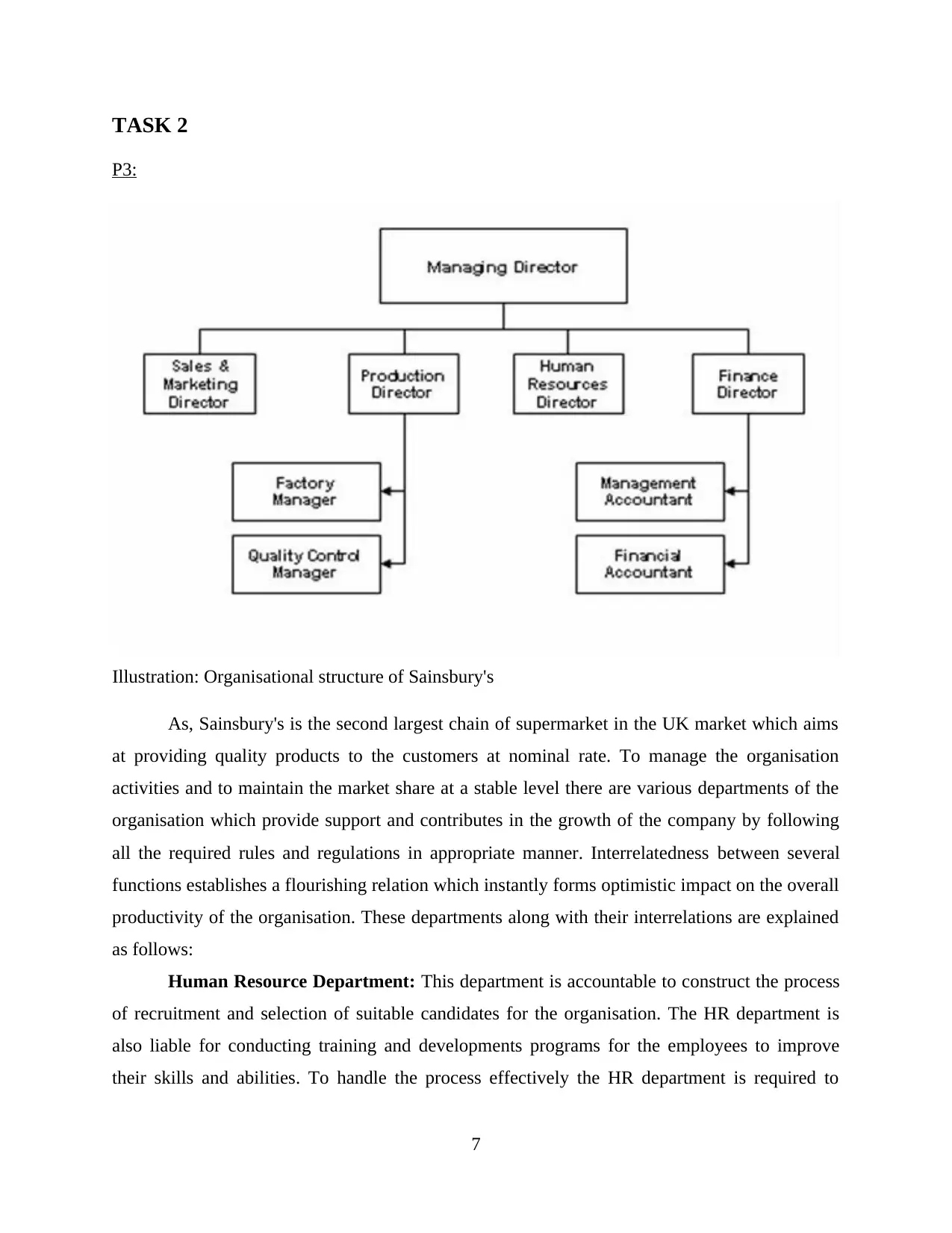
TASK 2
P3:
Illustration: Organisational structure of Sainsbury's
As, Sainsbury's is the second largest chain of supermarket in the UK market which aims
at providing quality products to the customers at nominal rate. To manage the organisation
activities and to maintain the market share at a stable level there are various departments of the
organisation which provide support and contributes in the growth of the company by following
all the required rules and regulations in appropriate manner. Interrelatedness between several
functions establishes a flourishing relation which instantly forms optimistic impact on the overall
productivity of the organisation. These departments along with their interrelations are explained
as follows:
Human Resource Department: This department is accountable to construct the process
of recruitment and selection of suitable candidates for the organisation. The HR department is
also liable for conducting training and developments programs for the employees to improve
their skills and abilities. To handle the process effectively the HR department is required to
7
P3:
Illustration: Organisational structure of Sainsbury's
As, Sainsbury's is the second largest chain of supermarket in the UK market which aims
at providing quality products to the customers at nominal rate. To manage the organisation
activities and to maintain the market share at a stable level there are various departments of the
organisation which provide support and contributes in the growth of the company by following
all the required rules and regulations in appropriate manner. Interrelatedness between several
functions establishes a flourishing relation which instantly forms optimistic impact on the overall
productivity of the organisation. These departments along with their interrelations are explained
as follows:
Human Resource Department: This department is accountable to construct the process
of recruitment and selection of suitable candidates for the organisation. The HR department is
also liable for conducting training and developments programs for the employees to improve
their skills and abilities. To handle the process effectively the HR department is required to
7
⊘ This is a preview!⊘
Do you want full access?
Subscribe today to unlock all pages.

Trusted by 1+ million students worldwide
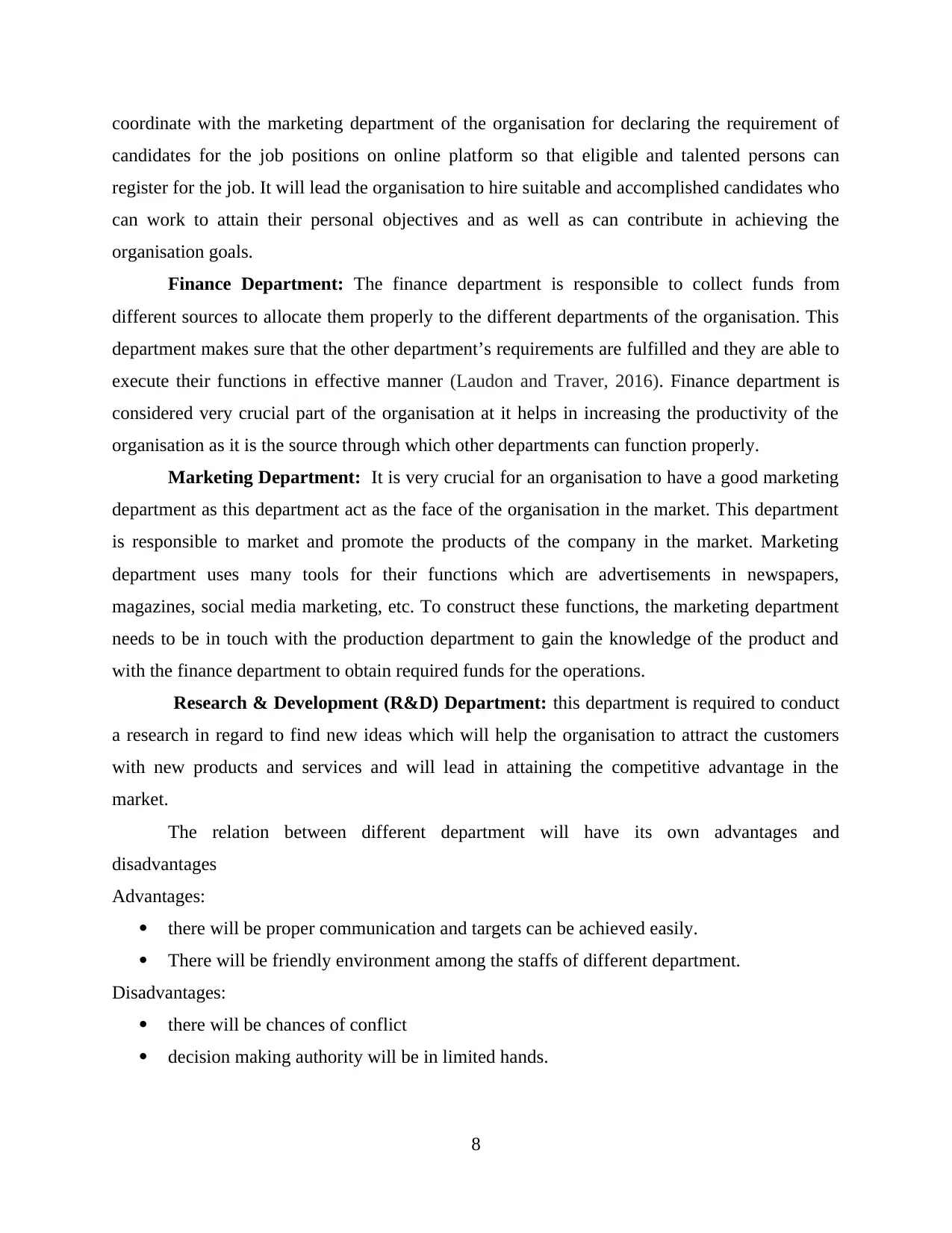
coordinate with the marketing department of the organisation for declaring the requirement of
candidates for the job positions on online platform so that eligible and talented persons can
register for the job. It will lead the organisation to hire suitable and accomplished candidates who
can work to attain their personal objectives and as well as can contribute in achieving the
organisation goals.
Finance Department: The finance department is responsible to collect funds from
different sources to allocate them properly to the different departments of the organisation. This
department makes sure that the other department’s requirements are fulfilled and they are able to
execute their functions in effective manner (Laudon and Traver, 2016). Finance department is
considered very crucial part of the organisation at it helps in increasing the productivity of the
organisation as it is the source through which other departments can function properly.
Marketing Department: It is very crucial for an organisation to have a good marketing
department as this department act as the face of the organisation in the market. This department
is responsible to market and promote the products of the company in the market. Marketing
department uses many tools for their functions which are advertisements in newspapers,
magazines, social media marketing, etc. To construct these functions, the marketing department
needs to be in touch with the production department to gain the knowledge of the product and
with the finance department to obtain required funds for the operations.
Research & Development (R&D) Department: this department is required to conduct
a research in regard to find new ideas which will help the organisation to attract the customers
with new products and services and will lead in attaining the competitive advantage in the
market.
The relation between different department will have its own advantages and
disadvantages
Advantages:
there will be proper communication and targets can be achieved easily.
There will be friendly environment among the staffs of different department.
Disadvantages:
there will be chances of conflict
decision making authority will be in limited hands.
8
candidates for the job positions on online platform so that eligible and talented persons can
register for the job. It will lead the organisation to hire suitable and accomplished candidates who
can work to attain their personal objectives and as well as can contribute in achieving the
organisation goals.
Finance Department: The finance department is responsible to collect funds from
different sources to allocate them properly to the different departments of the organisation. This
department makes sure that the other department’s requirements are fulfilled and they are able to
execute their functions in effective manner (Laudon and Traver, 2016). Finance department is
considered very crucial part of the organisation at it helps in increasing the productivity of the
organisation as it is the source through which other departments can function properly.
Marketing Department: It is very crucial for an organisation to have a good marketing
department as this department act as the face of the organisation in the market. This department
is responsible to market and promote the products of the company in the market. Marketing
department uses many tools for their functions which are advertisements in newspapers,
magazines, social media marketing, etc. To construct these functions, the marketing department
needs to be in touch with the production department to gain the knowledge of the product and
with the finance department to obtain required funds for the operations.
Research & Development (R&D) Department: this department is required to conduct
a research in regard to find new ideas which will help the organisation to attract the customers
with new products and services and will lead in attaining the competitive advantage in the
market.
The relation between different department will have its own advantages and
disadvantages
Advantages:
there will be proper communication and targets can be achieved easily.
There will be friendly environment among the staffs of different department.
Disadvantages:
there will be chances of conflict
decision making authority will be in limited hands.
8
Paraphrase This Document
Need a fresh take? Get an instant paraphrase of this document with our AI Paraphraser
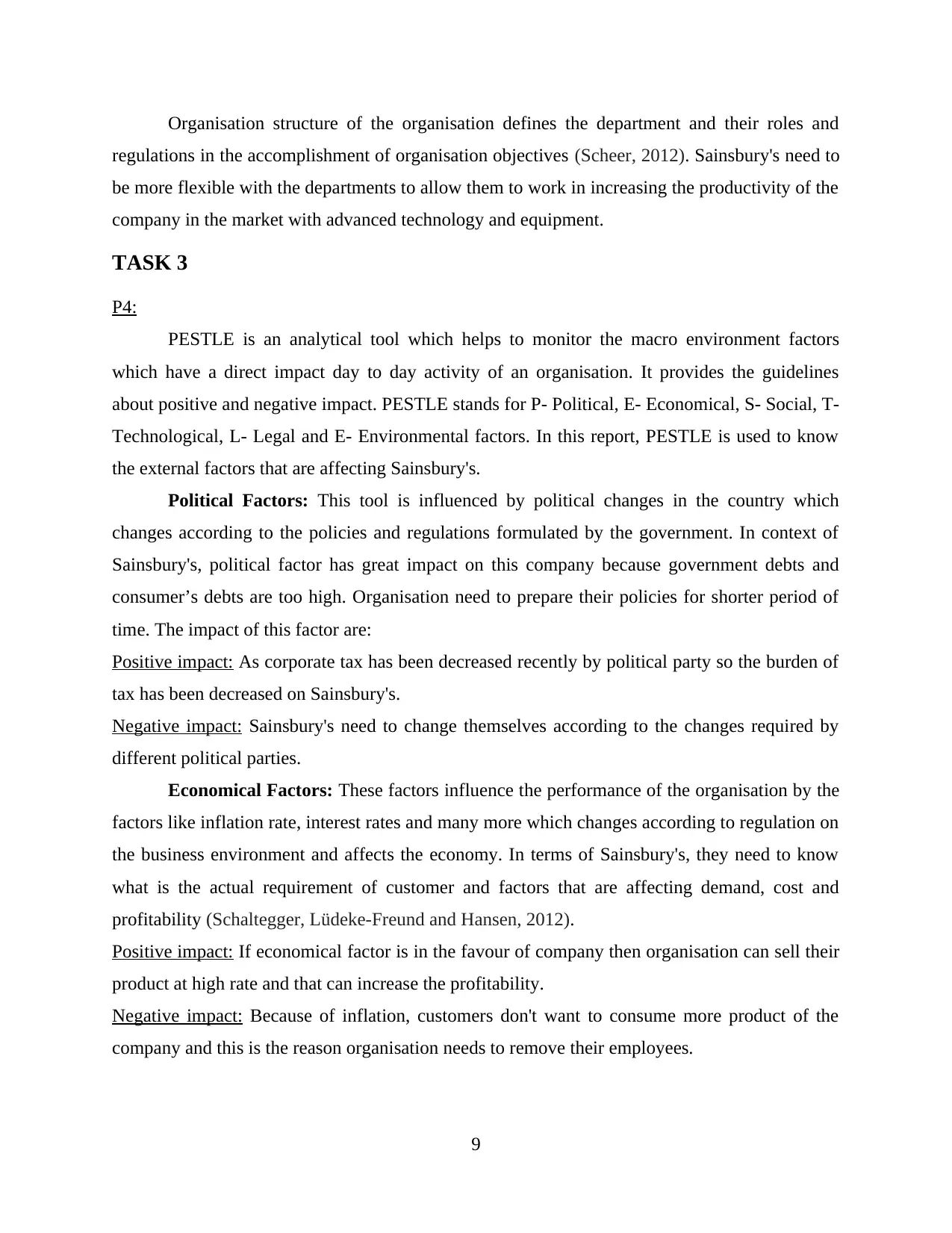
Organisation structure of the organisation defines the department and their roles and
regulations in the accomplishment of organisation objectives (Scheer, 2012). Sainsbury's need to
be more flexible with the departments to allow them to work in increasing the productivity of the
company in the market with advanced technology and equipment.
TASK 3
P4:
PESTLE is an analytical tool which helps to monitor the macro environment factors
which have a direct impact day to day activity of an organisation. It provides the guidelines
about positive and negative impact. PESTLE stands for P- Political, E- Economical, S- Social, T-
Technological, L- Legal and E- Environmental factors. In this report, PESTLE is used to know
the external factors that are affecting Sainsbury's.
Political Factors: This tool is influenced by political changes in the country which
changes according to the policies and regulations formulated by the government. In context of
Sainsbury's, political factor has great impact on this company because government debts and
consumer’s debts are too high. Organisation need to prepare their policies for shorter period of
time. The impact of this factor are:
Positive impact: As corporate tax has been decreased recently by political party so the burden of
tax has been decreased on Sainsbury's.
Negative impact: Sainsbury's need to change themselves according to the changes required by
different political parties.
Economical Factors: These factors influence the performance of the organisation by the
factors like inflation rate, interest rates and many more which changes according to regulation on
the business environment and affects the economy. In terms of Sainsbury's, they need to know
what is the actual requirement of customer and factors that are affecting demand, cost and
profitability (Schaltegger, Lüdeke-Freund and Hansen, 2012).
Positive impact: If economical factor is in the favour of company then organisation can sell their
product at high rate and that can increase the profitability.
Negative impact: Because of inflation, customers don't want to consume more product of the
company and this is the reason organisation needs to remove their employees.
9
regulations in the accomplishment of organisation objectives (Scheer, 2012). Sainsbury's need to
be more flexible with the departments to allow them to work in increasing the productivity of the
company in the market with advanced technology and equipment.
TASK 3
P4:
PESTLE is an analytical tool which helps to monitor the macro environment factors
which have a direct impact day to day activity of an organisation. It provides the guidelines
about positive and negative impact. PESTLE stands for P- Political, E- Economical, S- Social, T-
Technological, L- Legal and E- Environmental factors. In this report, PESTLE is used to know
the external factors that are affecting Sainsbury's.
Political Factors: This tool is influenced by political changes in the country which
changes according to the policies and regulations formulated by the government. In context of
Sainsbury's, political factor has great impact on this company because government debts and
consumer’s debts are too high. Organisation need to prepare their policies for shorter period of
time. The impact of this factor are:
Positive impact: As corporate tax has been decreased recently by political party so the burden of
tax has been decreased on Sainsbury's.
Negative impact: Sainsbury's need to change themselves according to the changes required by
different political parties.
Economical Factors: These factors influence the performance of the organisation by the
factors like inflation rate, interest rates and many more which changes according to regulation on
the business environment and affects the economy. In terms of Sainsbury's, they need to know
what is the actual requirement of customer and factors that are affecting demand, cost and
profitability (Schaltegger, Lüdeke-Freund and Hansen, 2012).
Positive impact: If economical factor is in the favour of company then organisation can sell their
product at high rate and that can increase the profitability.
Negative impact: Because of inflation, customers don't want to consume more product of the
company and this is the reason organisation needs to remove their employees.
9
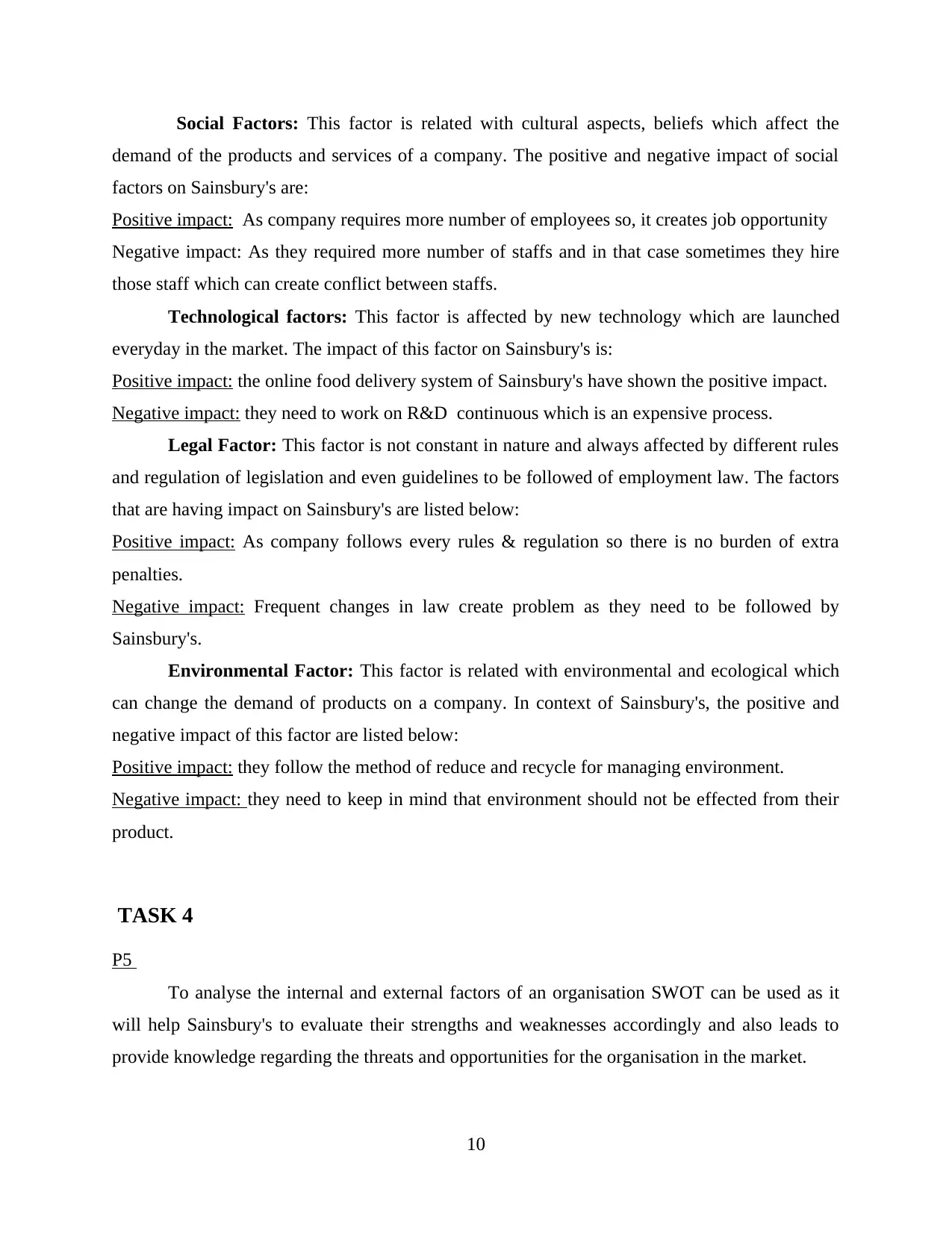
Social Factors: This factor is related with cultural aspects, beliefs which affect the
demand of the products and services of a company. The positive and negative impact of social
factors on Sainsbury's are:
Positive impact: As company requires more number of employees so, it creates job opportunity
Negative impact: As they required more number of staffs and in that case sometimes they hire
those staff which can create conflict between staffs.
Technological factors: This factor is affected by new technology which are launched
everyday in the market. The impact of this factor on Sainsbury's is:
Positive impact: the online food delivery system of Sainsbury's have shown the positive impact.
Negative impact: they need to work on R&D continuous which is an expensive process.
Legal Factor: This factor is not constant in nature and always affected by different rules
and regulation of legislation and even guidelines to be followed of employment law. The factors
that are having impact on Sainsbury's are listed below:
Positive impact: As company follows every rules & regulation so there is no burden of extra
penalties.
Negative impact: Frequent changes in law create problem as they need to be followed by
Sainsbury's.
Environmental Factor: This factor is related with environmental and ecological which
can change the demand of products on a company. In context of Sainsbury's, the positive and
negative impact of this factor are listed below:
Positive impact: they follow the method of reduce and recycle for managing environment.
Negative impact: they need to keep in mind that environment should not be effected from their
product.
TASK 4
P5
To analyse the internal and external factors of an organisation SWOT can be used as it
will help Sainsbury's to evaluate their strengths and weaknesses accordingly and also leads to
provide knowledge regarding the threats and opportunities for the organisation in the market.
10
demand of the products and services of a company. The positive and negative impact of social
factors on Sainsbury's are:
Positive impact: As company requires more number of employees so, it creates job opportunity
Negative impact: As they required more number of staffs and in that case sometimes they hire
those staff which can create conflict between staffs.
Technological factors: This factor is affected by new technology which are launched
everyday in the market. The impact of this factor on Sainsbury's is:
Positive impact: the online food delivery system of Sainsbury's have shown the positive impact.
Negative impact: they need to work on R&D continuous which is an expensive process.
Legal Factor: This factor is not constant in nature and always affected by different rules
and regulation of legislation and even guidelines to be followed of employment law. The factors
that are having impact on Sainsbury's are listed below:
Positive impact: As company follows every rules & regulation so there is no burden of extra
penalties.
Negative impact: Frequent changes in law create problem as they need to be followed by
Sainsbury's.
Environmental Factor: This factor is related with environmental and ecological which
can change the demand of products on a company. In context of Sainsbury's, the positive and
negative impact of this factor are listed below:
Positive impact: they follow the method of reduce and recycle for managing environment.
Negative impact: they need to keep in mind that environment should not be effected from their
product.
TASK 4
P5
To analyse the internal and external factors of an organisation SWOT can be used as it
will help Sainsbury's to evaluate their strengths and weaknesses accordingly and also leads to
provide knowledge regarding the threats and opportunities for the organisation in the market.
10
⊘ This is a preview!⊘
Do you want full access?
Subscribe today to unlock all pages.

Trusted by 1+ million students worldwide
1 out of 17
Related Documents
Your All-in-One AI-Powered Toolkit for Academic Success.
+13062052269
info@desklib.com
Available 24*7 on WhatsApp / Email
![[object Object]](/_next/static/media/star-bottom.7253800d.svg)
Unlock your academic potential
Copyright © 2020–2025 A2Z Services. All Rights Reserved. Developed and managed by ZUCOL.





